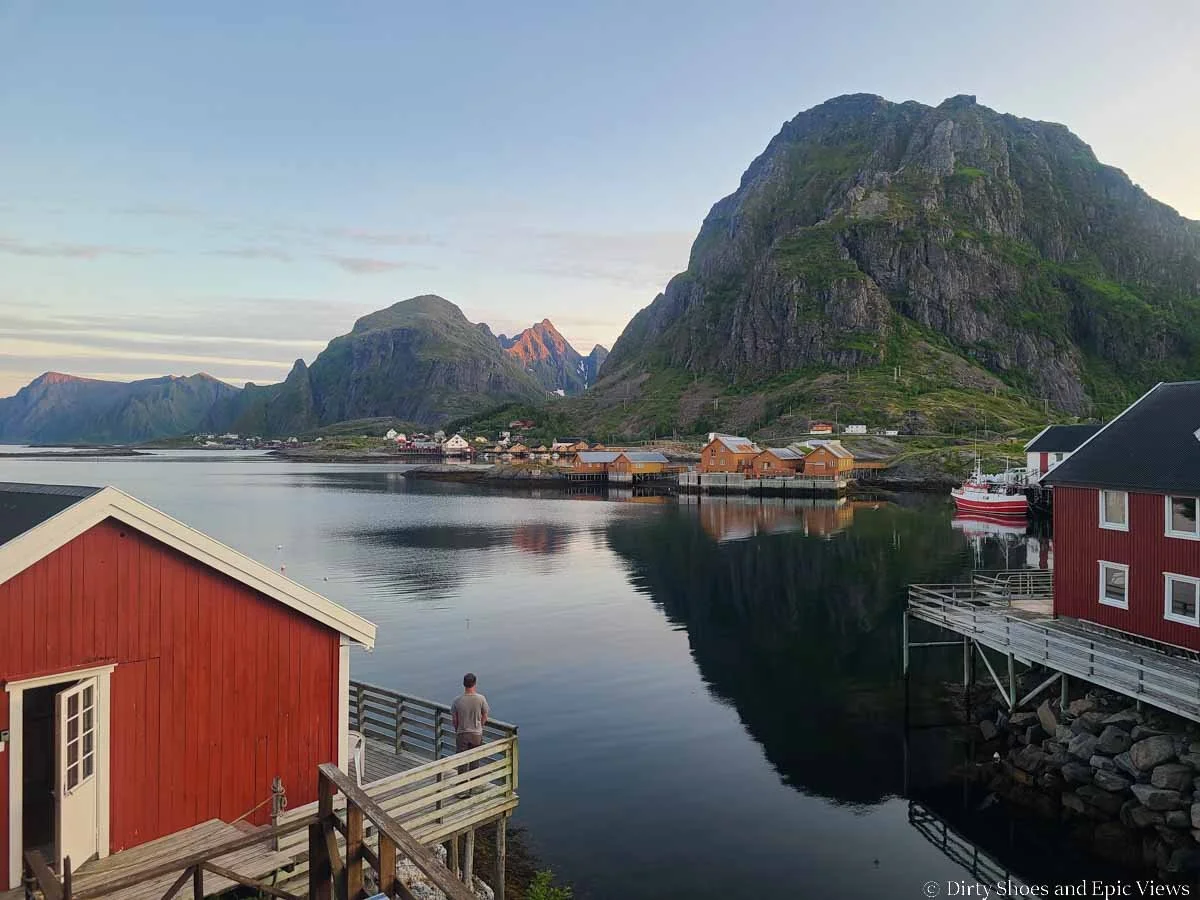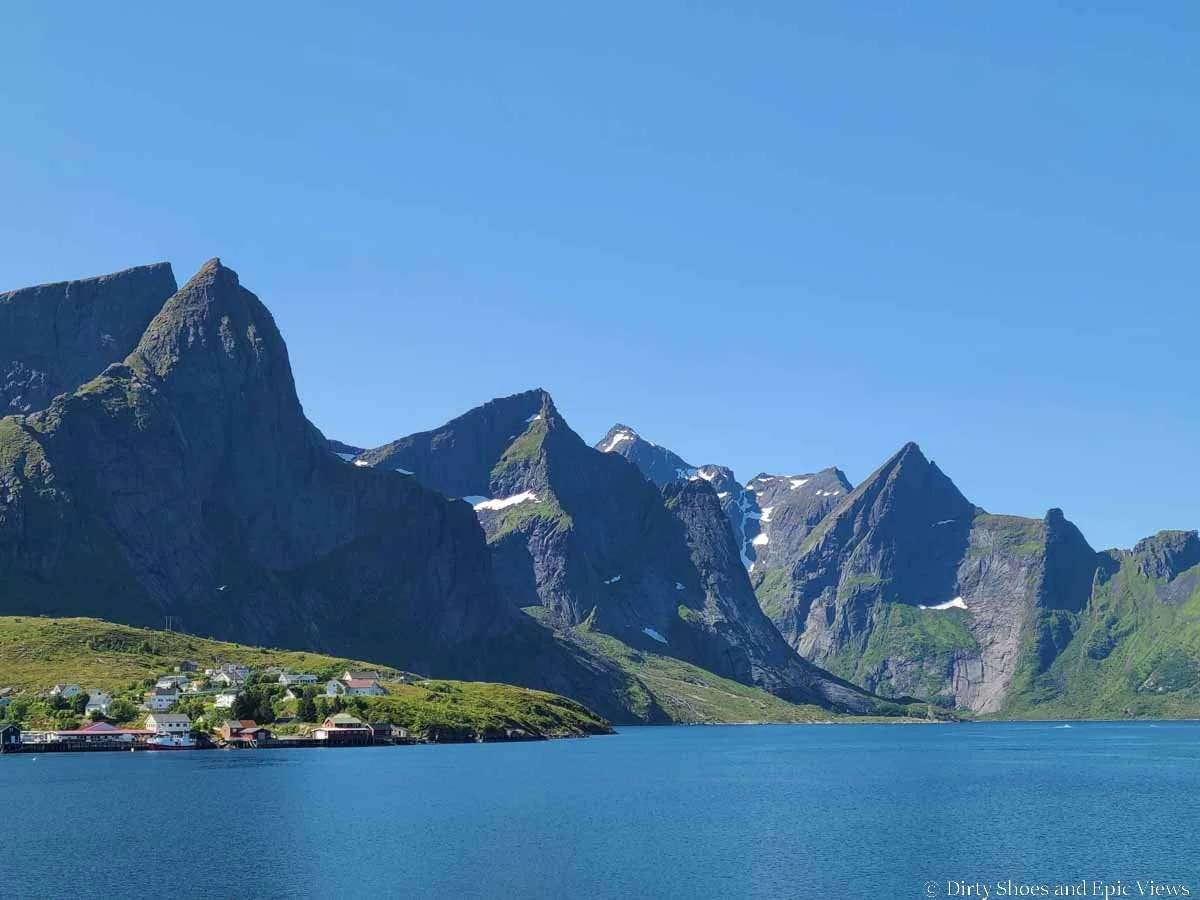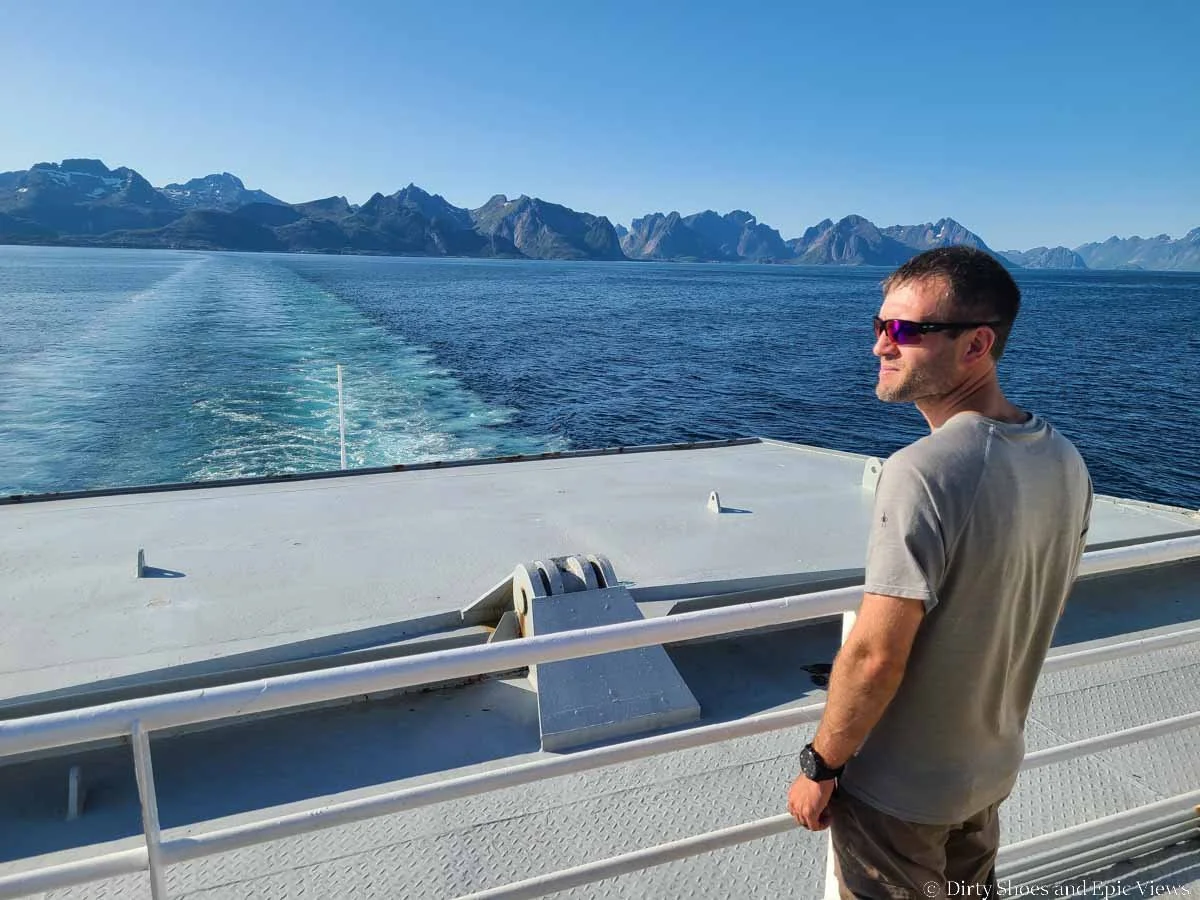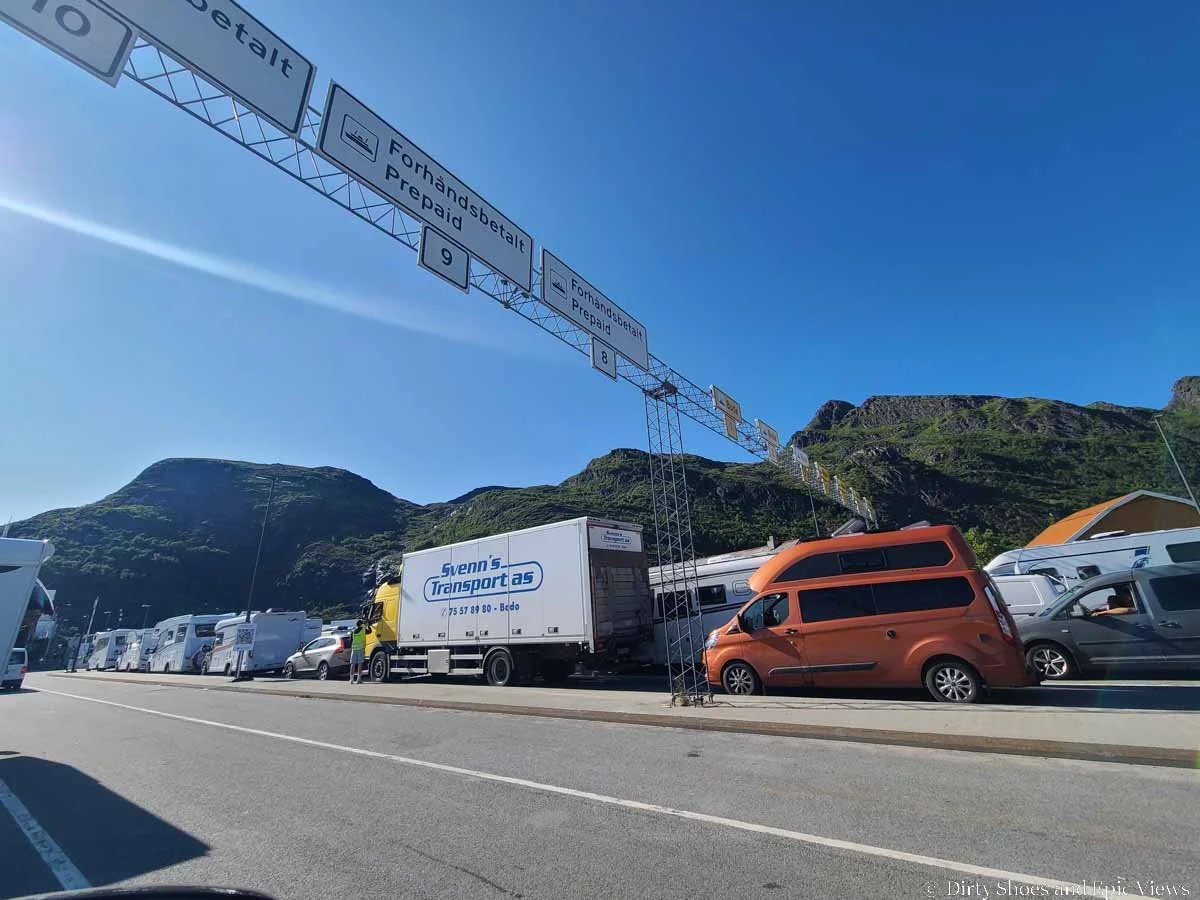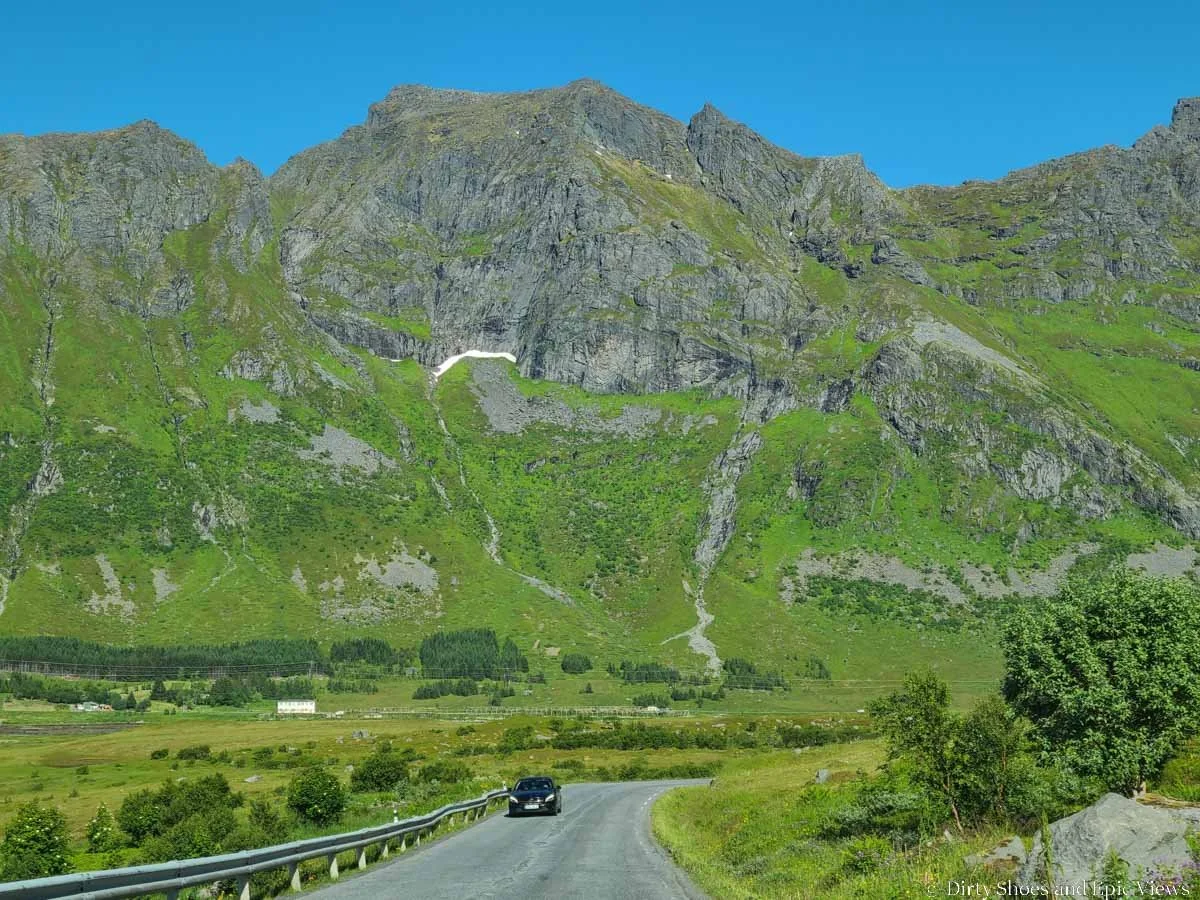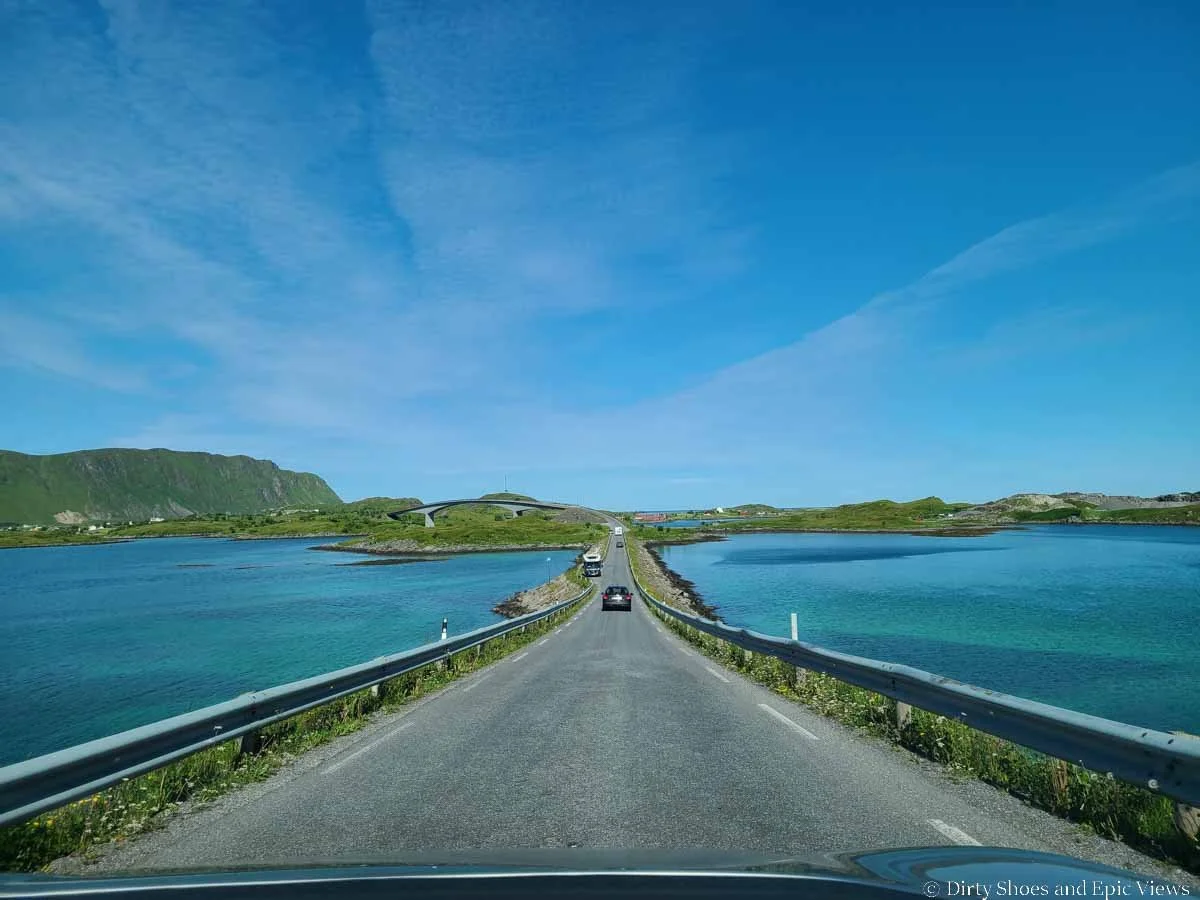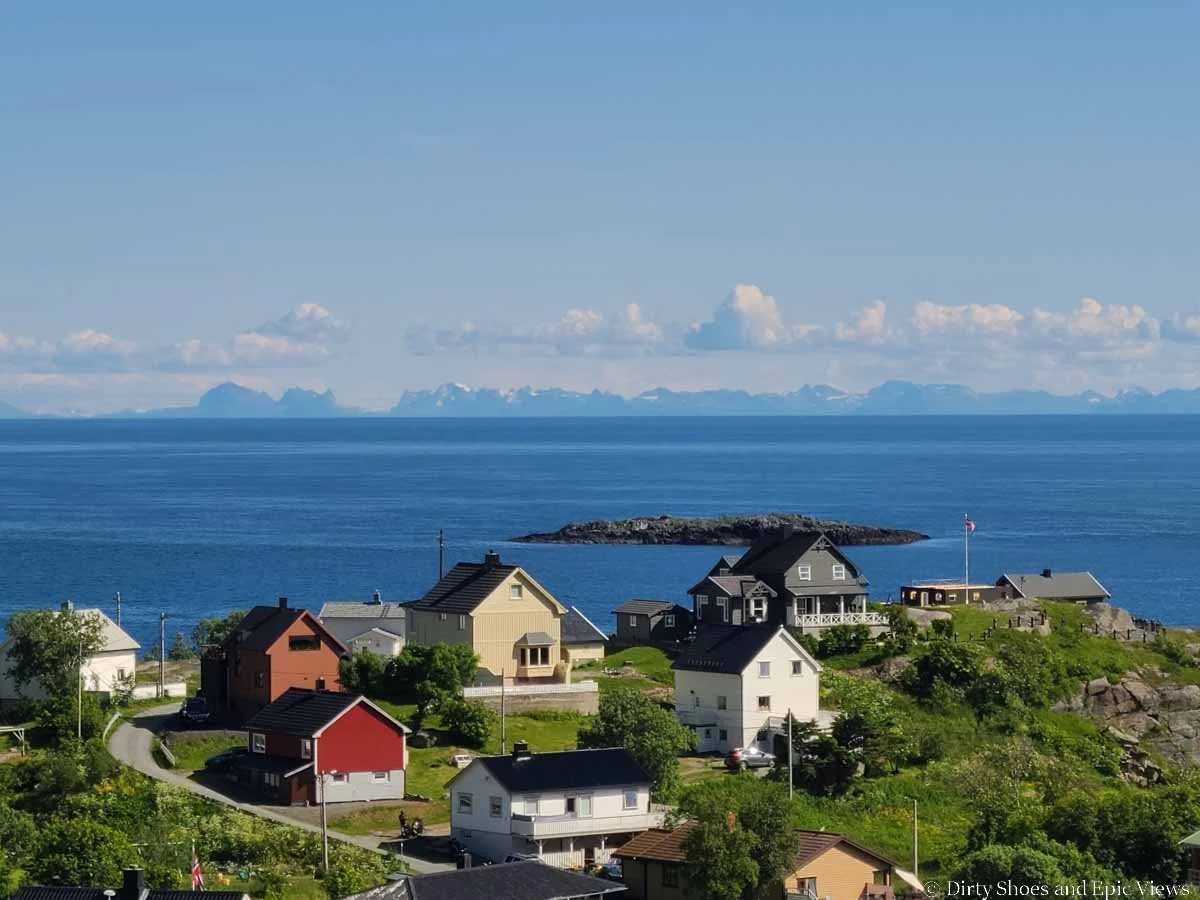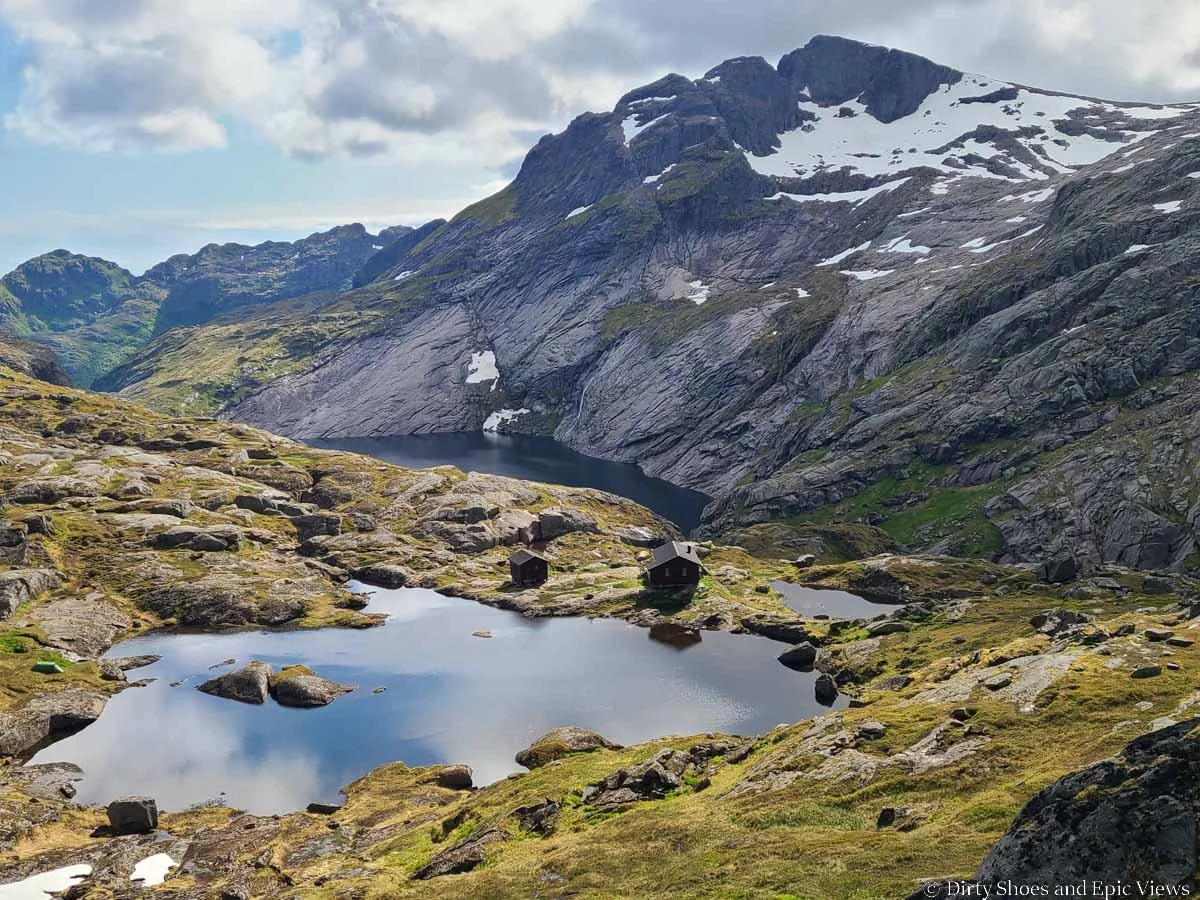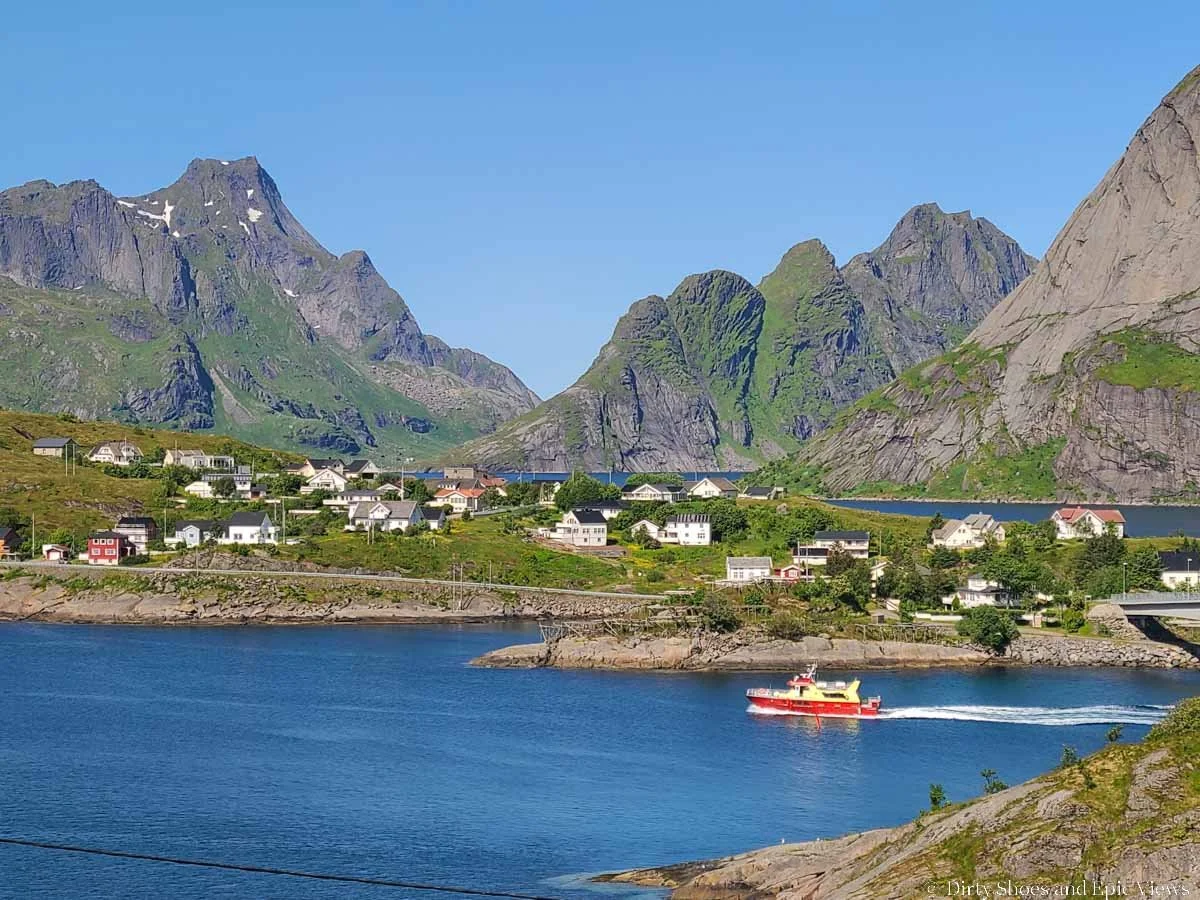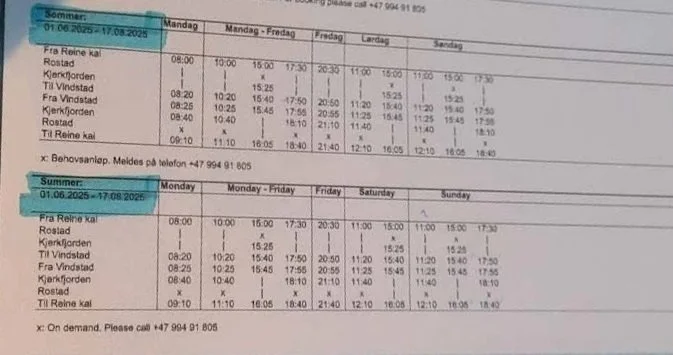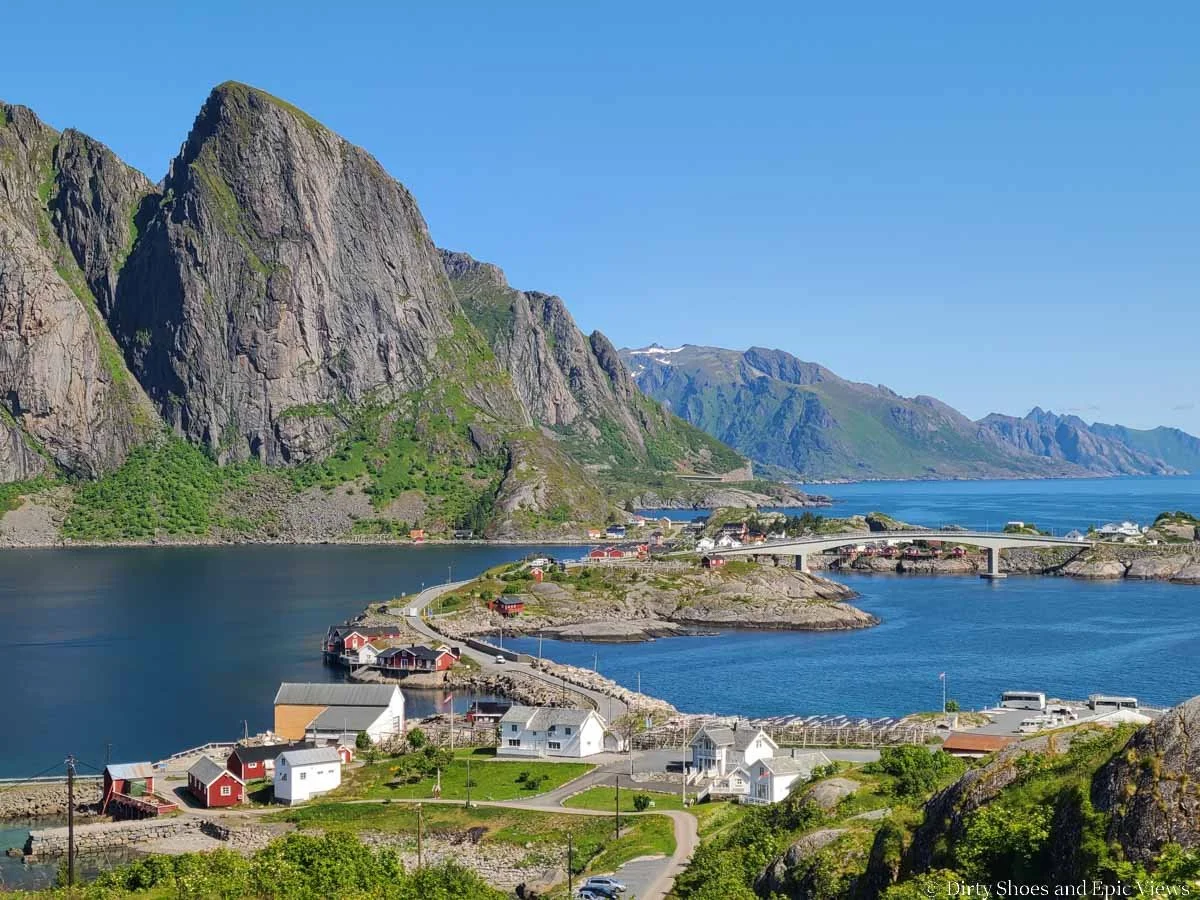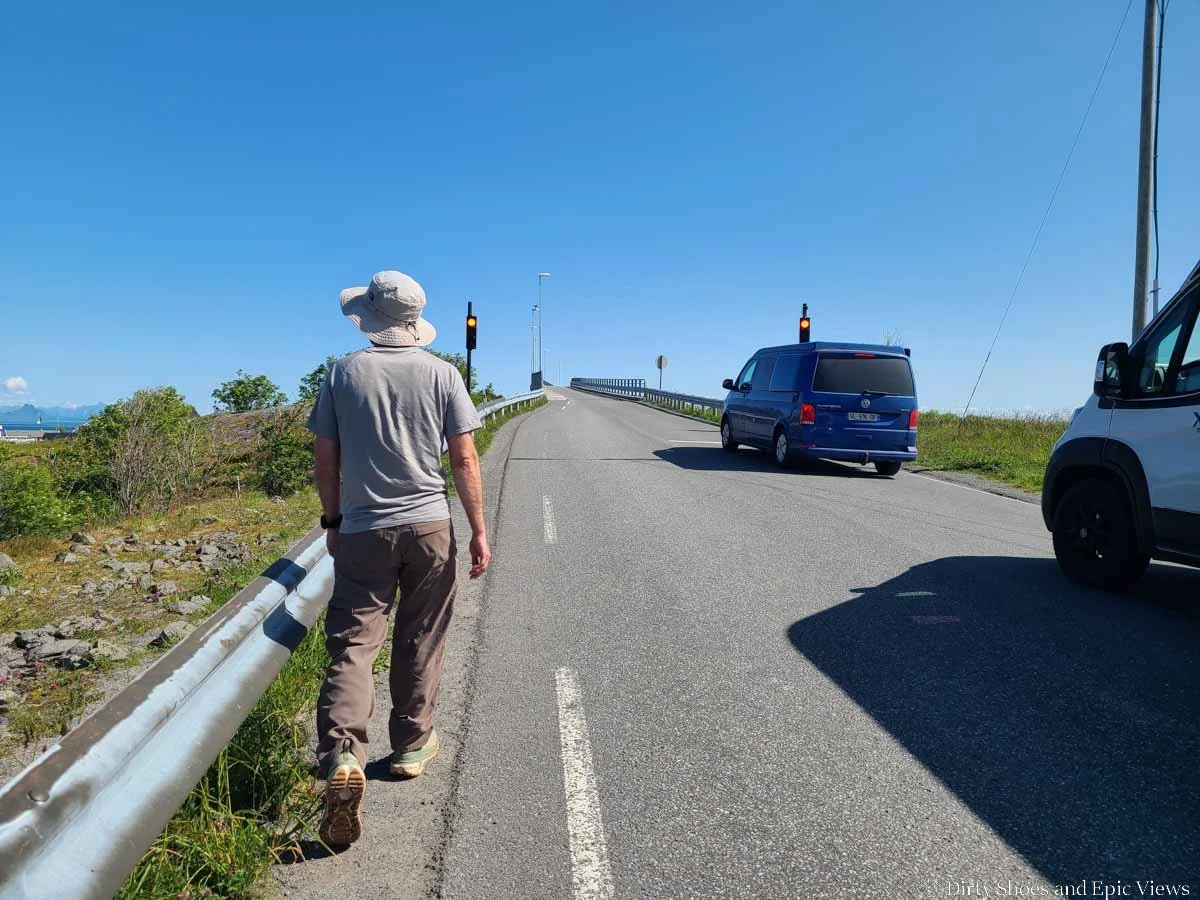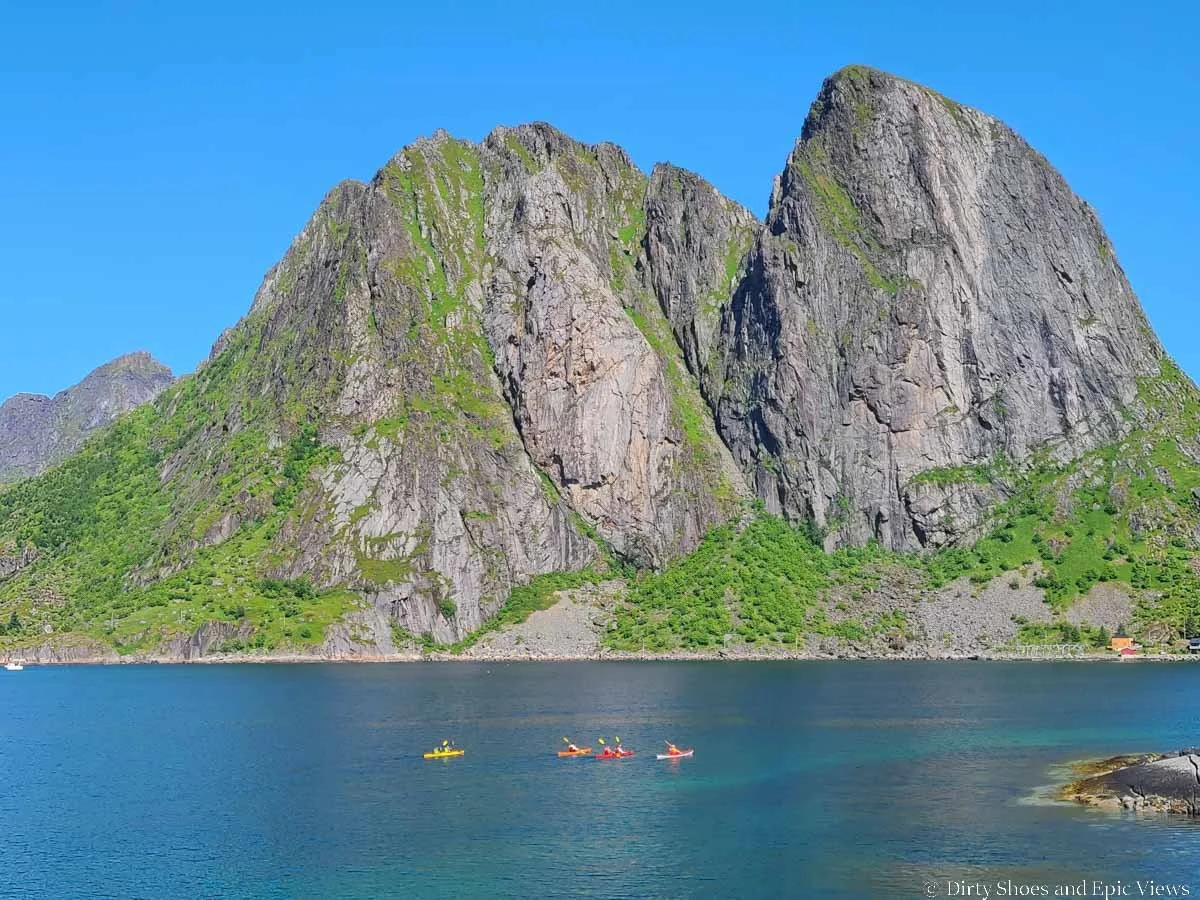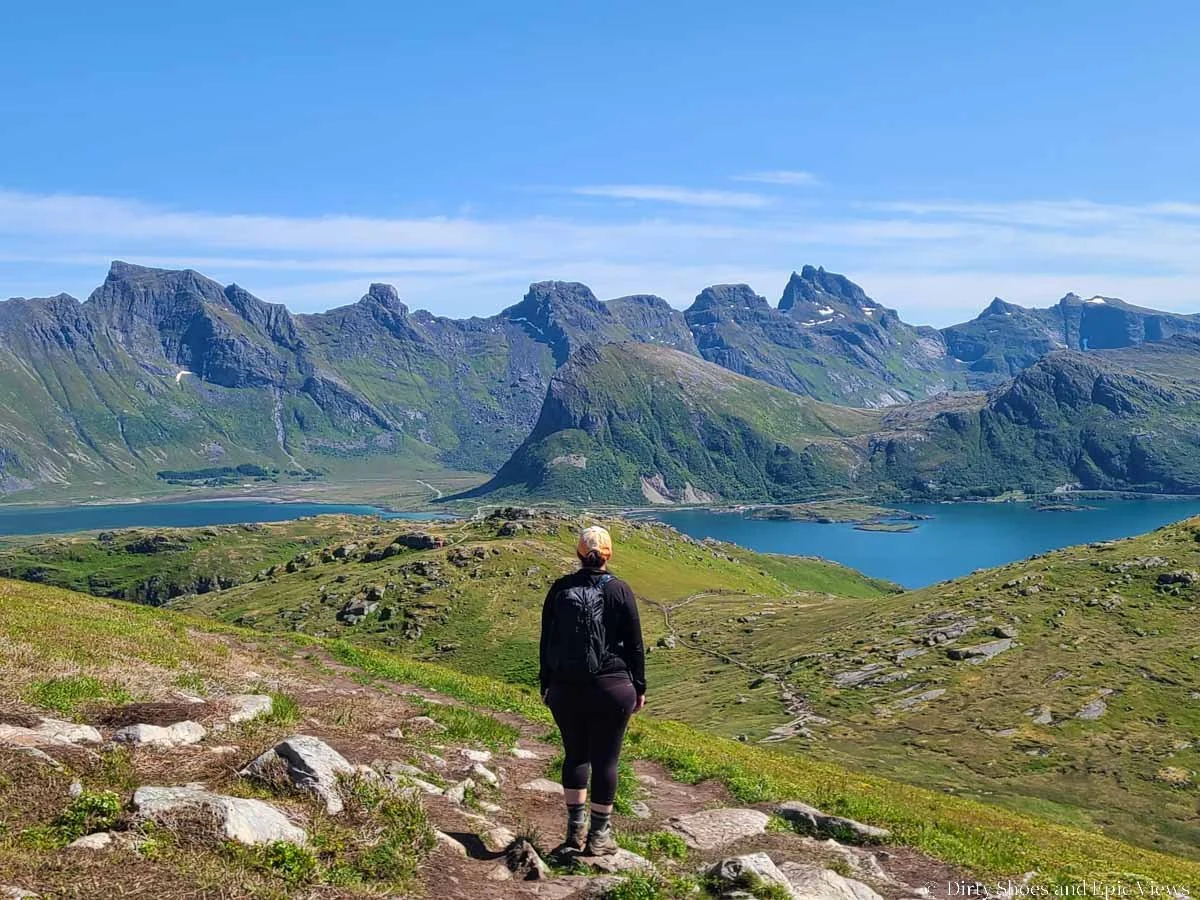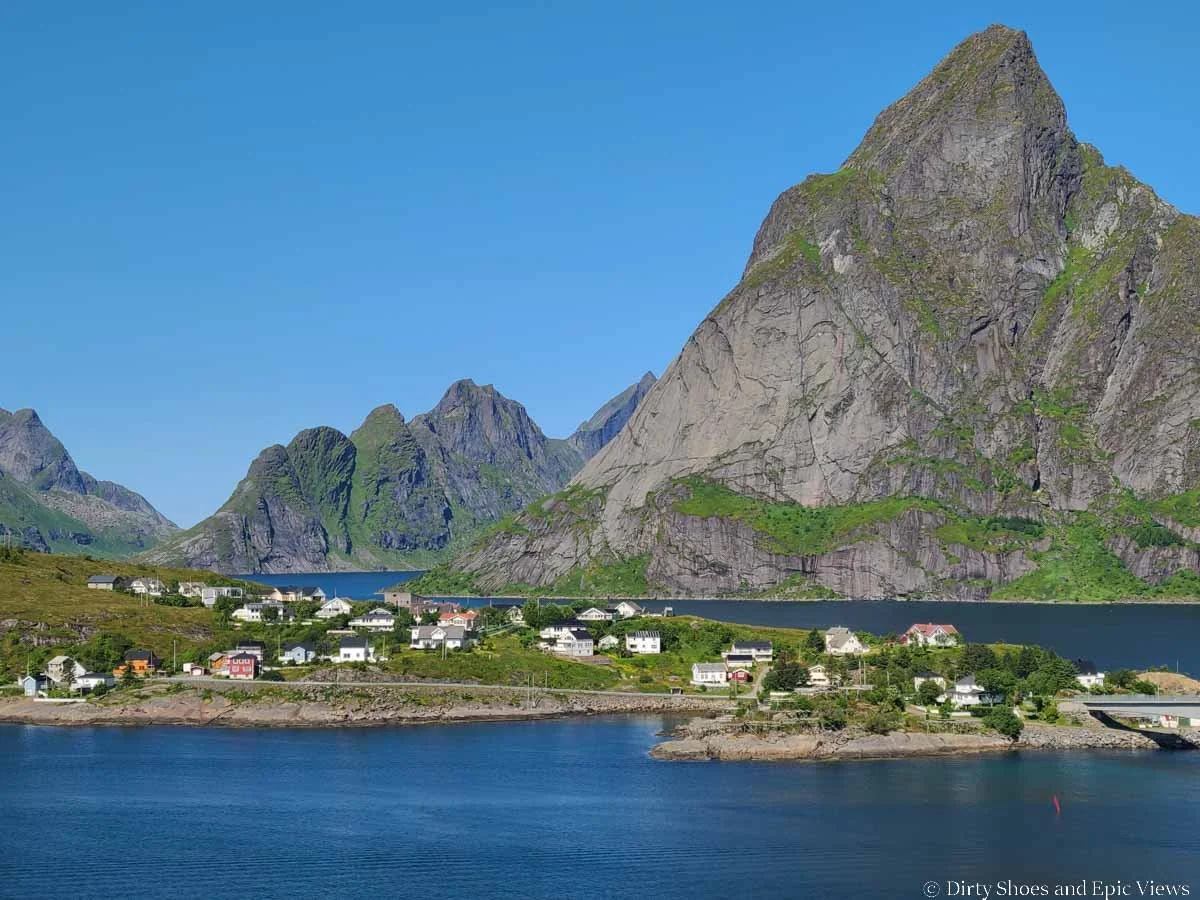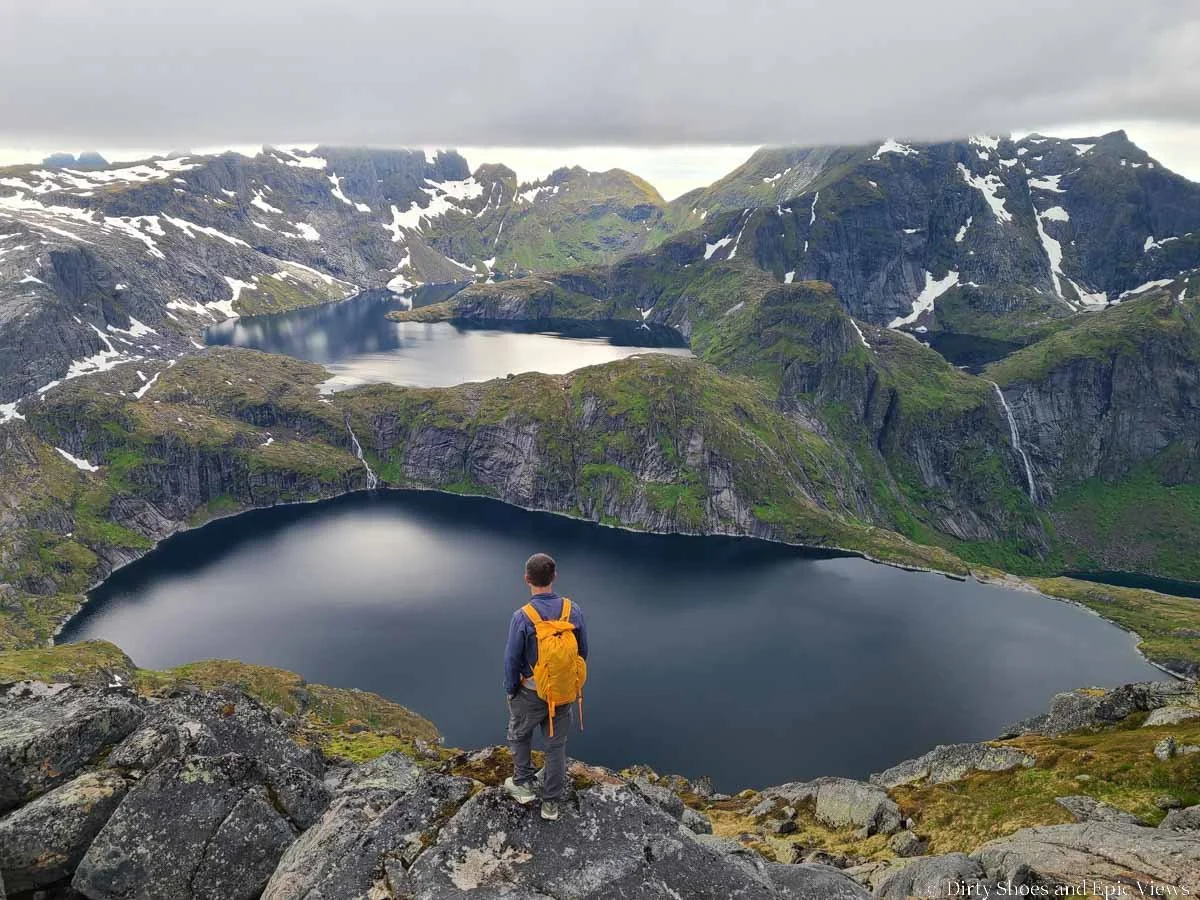How to Visit the Lofoten Islands: Things to Do, Itinerary + Complete Travel Guide
Are the Lofoten Islands in Norway on your bucket list? Then you’re in the right place! In this guide, we’ll share everything you need to know about how to visit the Lofoten Islands. We’ll go over how to get to the Lofoten Islands, how to get around, all the amazing things to do in the Lofoten Islands, share some Lofoten Islands itineraries, and give you all our best tips for visiting this amazing place in Norway!
The Lofoten Islands of Norway are one of the most unique and stunning places we’ve ever been to.
Located above the Arctic Circle, this chain of beautiful islands is made up of dramatic and jagged peaks that rise straight out of the ocean, scenic fjords surrounded by cliffs and mountains, cute and charming fishing villages, and beaches of white sand and surprisingly clear turquoise water that will make you feel like you’re somewhere tropical rather than in the Arctic Circle.
While the scenery is stunning on its own, the Lofoten Islands are filled with adventure and there are lots of ways you can fill your time and enjoy the views without ever getting bored or tired of this amazing place. The islands are filled with epic hiking trails with views over jagged peaks, deep blue lakes, and turquoise beaches, but you can also kayak through the beautiful fjords, go rock climbing, take scenic cruises, and, you can even go surfing!
What’s even more special is that depending on time of year, you can also experience the midnight sun or gaze up at the northern lights dancing across the sky.
Have we convinced you yet that the Lofoten Islands should be on your bucket list?
If so, then stick around, because in this guide, we’ll go over all the important info you need to plan a visit to the Lofoten Islands. We’ll share how to get to the Lofoten Islands (this one takes a bit of planning!), all the epic things to do on the Lofoten Islands, how much time you need for your visit, share some awesome Lofoten Islands itineraries, and give you all our best tips so that you can experience this special corner of the world for yourself.
So, let’s get into it!
In this Lofoten Islands guide and itinerary:
Where Are the Lofoten Islands?
The Lofoten Islands are an archipelago, or chain of islands, located off the western coast of Northern Norway.
Typical views on the Lofoten Islands
There are five main islands (Moskenesoya, Flakstadoya, Vestvagoya, Gimosoya, and Austvagoya) that make up the archipelago. These are all connected via a main route (the E10) that spans almost 180 km (112 miles) using bridges and winding roads that travel past epic mountain scenery, fjords, and beaches. There are also some other smaller, more remote islands that are part of the archipelago that you can get to by ferry (such as the island of Vaeroy).
When looking at a map of the Lofoten Islands, some good reference points include the town of Svolvaer and the village of A.
Svolvaer is the largest town and considered the capital of and gateway to the Lofoten Islands. This is on the eastern edge of the Lofoten Islands.
The furthest point that you can drive to the western/southern edge of the Lofoten Islands is the small fishing village of A. This is just past Reine, another fishing village that has become hugely popular and has some of the most iconic and beautiful scenery in the Lofoten Islands.
It’s only about a two- hour drive between Svolvaer and A, but within this span of driving are miles and miles of epic scenery, dramatic peaks, white sand beaches, ocean views, turquoise waters, deep fjords, and historic fishing villages. The scenery here is non-stop, and you can spend weeks here exploring all the nooks and crannies of these islands and never get bored.
You’ll never get sick of the views on a road trip through the Lofoten Islands!
One thing that makes the Lofoten Islands special is that they actually lie above the Artic Circle, so for almost two months in the summer, the sun never sets and you can experience the midnight sun (which is super cool!), and for about a month in the winter, you can experience the polar night where the sun never rises above the horizon.
Lofoten Islands map
Here is a general overview of where the Lofoten Islands are and some of the main towns along the way. It will be useful to use this map as a reference when we talk about how to get to the Lofoten Islands next.
Map of the Lofoten Islands and relevant towns in and around them
How to Get to the Lofoten Islands in Norway
Taking a ferry to the Lofoten Islands
The Lofoten Islands are quite a remote destination, so you might guess that getting there can be a bit of an adventure…and you’d be right.
There are a few ways to get to the Lofoten Islands, and how you do it depends on a few things:
How much you want to spend
How much time you have
Where in the Lofoten Islands you plan on spending your time
So, let’s get into the different ways to get to the Lofoten Islands…
How to fly to the Lofoten Islands
The most convenient and fastest way to get to the Lofoten Islands is to fly.
There are two small airports right on the Lofoten Islands, one in Leknes, and one in Svolvaer. You’ll likely be flying to either of these airports from Oslo in Norway. For flights that fly from Oslo to the Lofoten Islands, it’s best to look at the Wideroe website, which is the main airline that will get you to either of these two airports.
When we were looking at our options, we only saw one daily direct flight from Oslo to each of these two Lofoten airports. The rest of the flights each day (and there are many throughout the day) involve a brief transfer, usually in the town of Bodo, but sometimes in Tromso, via another airline (SAS or Norwegian) before flying into Lofoten via Wideroe. Likely, you’ll be taking one of these indirect flights that better match with your schedule.
Pros of flying to Lofoten: Flying into Leknes or Svolvaer is ideal because the flights are short and they’ll put you right on the Lofoten Islands. Leknes in particular is centrally located, but even if you fly into Svolvaer, you’re only a 2-hour drive to Reine on the other end of the islands. This is a good option for those who are short on time and want the fastest way to the Lofoten Islands. It’s also a good option for people who want to road trip through the Lofoten Islands and explore all parts of it.
Cons of flying to Lofoten: Flights to the Lofoten Islands can be pretty pricey compared to other options, especially if you want a direct flight. Car rentals in these small Lofoten towns may also be limited or more expensive as well.
Many flights (at least from Oslo) can also sell out in advance, and prices increase noticeably the closer you are to your travel dates, so it’s definitely best to book your flights a few months out if possible. When we were looking just weeks to a month in advance, there were definitely limited options and increased prices.
Another option for flying to the Lofoten Islands
There is also an airport in Evenes, Norway, which is outside of the Lofoten Islands, but is a good starting point for a road trip onto the islands. You can fly to the Harstad/Narvik airpoirt here, rent a car, and start your drive. From here, it will be about a 2.5-hour drive to get to Svolvaer, or an almost 5- hour drive to get to Reine.
We found flights to Evenes to be a little cheaper than flying directly into Lofoten, and car rental prices here were more affordable than all our other options as well. However, you have to factor in the time driving there and back. If you have a lot of time on the Lofoten Islands for a longer road trip, or perhaps want to combine exploring the Lofoten Islands with the rest of Northern Norway, using the Evenes airport could be a good central spot. But if you want to focus solely on Reine, for example, this wouldn’t be the most ideal option for getting there.
Taking a ferry to the Lofoten Islands
The Bodo-Moskenes ferry
Another option for getting to the Lofoten Islands is by ferry. To do this, you’d fly first to Bodo, located directly across Lofoten on the Norway’s mainland.
In Bodo, you can rent a car and then take a ferry directly from Bodo to Moskenes on the western/southern tip of the Lofoten Islands (which is less than ten minutes from Reine)- this is what we did.
The ferry from Bodo to Moskenes takes between 3.5 to 4 hours. We actually enjoyed it- it was pretty relaxing and comfortable and the ride goes fairly fast. The views pulling out of Bodo and then into Moskenes are really pretty, and arriving to the Lofoten Islands by boat just made the experience more unique- like we were going somewhere really remote and special.
Views of the Lofoten Islands from the ferry
Check out this site for the most updated timetables and pricing for the Bodo-Moskenes ferry. There is a cost for vehicles, but not walk-on passengers, so if you are going without a car, the Bodo to Moskenes ferry is free (we’d recommend renting your car in Bodo, though, as finding rentals around Moskenes can be tricky). The price for a vehicle depends on the size (so campervans and motorhomes will be more expensive than regular cars) and also the type (electric vehicles get a discounted price over gas cars).
Do you need to reserve the Bodo-Moskenes ferry?
If you are taking a vehicle, we’d highly recommend reserving a spot on the Bodo ferry. Half of the ferry’s capacity is reservable in advance. Reserving does come with an extra fee, but it also comes with the peace of mind knowing that you will get a spot on the ferry you want (or need).
With a reservation, you have to show up at least 45 minutes in advance to give the attendants time to check everyone in. There will be lots of lanes at the port, so just be sure to drive into a lane with a sign above it that says Moskenes (or Bodo, depending on which direction you’re traveling) and “Reserved” or “Prepaid”.
And just a head’s up- we saw that this 45 minute cutoff is pretty strict. Right at 45 minutes before departure, they were placing cones across the lanes preventing more cars from entering! If you aren’t there on time, it’s possible that your spot will be given up to a first-come first-serve car.
If you don’t have a reservation, the ferry is first-come first-serve, and people often line up hours in advance. When you get to the port, get in the lane marked for Moskenes, or Bodo, without a reserved or prepaid indication. When we arrived about an hour in advance at the Bodo port, about half of the non-reserved lanes were filled up for a weekday evening ferry to Moskenes. Then, when we arrived at the Moskenes port on a Sunday evening about an hour early, it looked like most of the non-reserved lanes were filled and it looked like people had been camping out there for some time. I’m not sure if all of them were able to get on the ferry or if they had to wait another few hours for the next one.
Make sure to get in the right lane at the ferry terminal! You can see here that the non-reserved lanes were pretty full. This is at the ferry terminal in Bodo.
This is the ferry terminal in Moskenes on the Lofoten Islands. Again, the non-reserved lanes were quite full.
So our advice? Make a reservation. The extra cost was a little hard to swallow, but we were so glad we did it. It saved us a lot of time by not having to get to the ferries hours in advance to try and guarantee a spot, and it gave us the peace of mind knowing we’d make it to Lofoten Islands and back when we needed to (in order to make reservations, flights, etc).
Pros of taking a ferry to the Lofoten Islands: Flying into Bodo was cheapest and required just a single flight from Oslo. It’s nice to minimize driving and let the ferry shuttle you over (you can hang out, relax, enjoy the views, and grab a meal at the ferry café). Taking the ferry is ideal for people who want to focus their time on the Lofoten Islands in and around Reine, one of the island’s most scenic and iconic spots. The ferry will bring you pretty much right next to Reine and then you don’t have to do much driving from there.
Cons of taking a ferry to the Lofoten Islands: The ferry can be expensive, particularly if you reserve in advance or have a motorhome or campervan.
The ride can be choppy, even in nice weather (we did experience some rocking of the boat but not enough to make us seasick or nauseous). The ferry is known to be canceled or delayed due to bad weather or choppy waters, however we read that this rarely happens during the summer (it’s mainly during the fall and winter when storms roll through).
Another con is that the ferry times don’t coordinate with incoming flights at all, so you may have a lot of down time to kill in Bodo while waiting for your ferry. This makes taking the ferry the most time-consuming way to get to the Lofoten Islands.
Driving to the Lofoten Islands
Driving in the Lofoten Islands
It is definitely possible to drive to the Lofoten Islands. The islands are connected to each other, other islands, and to the mainland by bridges and ferries (depending on which way you’re coming from). Regardless, it will be a long drive, but often, people combine a visit to the Lofoten Islands with other areas in Northern Norway (such as Tromso and Senja), so making a road trip out of all of these destinations is certainly a possibility for those with a lot of time.
So, how should you get to the Lofoten Islands?
Well, like we said at the start, this depends on a lot of factors.
Budget: We recommend pricing out all of the different options and comparing them (this is ultimately how we decided what to do). We calculated what each of the flights to all the different airports would be, factored in car rental costs in each place, and added in the cost of the ferry. Don’t forget to factor in rough estimates for gas/electricity if considering doing longer drives into the islands (from Evenes, for example). Sometimes, things evened out. For example, it was way cheaper to fly into Bodo than to Evenes for us, but then car rentals were cheaper in Evenes. But overall, flying into Bodo and taking the ferry was cheapest for us.
Time: If you don’t have a lot of time to spend on the Lofoten Islands, flying directly to Leknes (or Svolvaer) would be best. This gets you there the fastest and puts you right in the middle of the islands.
Itinerary: Do you want to see all of the Lofoten Islands, or just concentrate in one area? We were mainly interested in the area and hikes around Reine, so taking the ferry from Bodo to Moskenes made the most sense for us and minimized driving time while on the islands (and gave us more time to explore and hike!). But if you want to see more of the islands and do a longer road trip, flying into Leknes, Svolvaer, or even Evenes may work better.
You can also consider flying into one airport like Evenes, road tripping down the islands, and flying out of Leknes, or even taking the one-way ferry to Bodo and flying out from there to avoid backtracking in your car all the way back to Evenes. However, this would add considerable expense in one-way flights and car fees!
How to Get Around the Lofoten Islands
Scenic driving through the Lofoten Islands
One of the biggest questions that gets asked is whether you need a car in the Lofoten Islands, and we would say the answer is a definite yes.
While there are public buses on the islands, having a car (or campervan/motorhome) gives you so much more flexibility to have your own schedule, work around weather, and explore off-the-beaten-path places. It’s not cheap to rent a car in Norway, but we think it’s well worth it.
Gas versus electric cars on the Lofoten Islands
As you are looking for car rentals in Norway, you might see that Norway has a strong emphasis on electric cars. Often, they are much cheaper to rent, and they usually will get you cheaper fares for road tolls and ferries as well.
The charging infrastructure is also widespread throughout the country, and you can usually easily find charging stations at most gas stations and even at some hotels and tourist centers. As a side note, we have read that people often have trouble with chargers, saying that the apps needed to pay for them are glitchy or simply don’t work, but we don’t have experience with this.
While we debated more about having an electric car for our much longer road trip through Norway’s southern fjords, we thought having an electric car for the Lofoten Islands was a good choice. We stuck mostly around Reine and the surrounding areas and didn’t have to drive too much, so an electric car worked perfectly. We didn’t have to plan our driving around when and where to charge. In fact, we charged just once at the end of our trip for about an hour or so and we were good!
Even if you plan on roadtripping through the Lofoten Islands between Svolvaer and Reine, this isn’t too much driving, and you can easily find charging stations at the end of each day or every other day as needed.
Driving on the Lofoten Islands
Driving on the Lofoten Islands is pretty straightforward. Everything is well-signed and the roads are well-maintained.
The main road through the islands is the E10, and it’s a standard two-lane road in many areas, but it can get narrow and windy at times. Sometimes you might encounter some rather blind turns on particularly narrow sections of road, so just take it slow and be prepared to stop and hug the shoulder more.
Driving along the E10- the main route through the Lofoten Islands
The roads on the Lofoten Islands can occassionally get narrow and have some blind turns
Drive slowly and stay cautious for oncoming cars, bikers, and pedestrians!
Some bridges are narrower as well or might be one-lane, particularly through small towns, so it’s important to keep your eyes ahead to see what any oncoming traffic is doing.
Some roads and bridges can be single-lane, so keep your eye out for oncoming traffic and any usefull pull-off areas
In the peak summer season, there will be quite a bit of congestion, particularly through the smaller fishing towns like Reine, Sakrisoy, and Hamnoy. Roads are narrow through these towns and you’ll have to keep your eyes out for pedestrians, bikers, oncoming cars, and navigate narrower roads with larger motorhomes and tour buses. It might feel a bit chaotic at times, but once you’re out of these smaller towns and back on the main roads in between them, it gets much better.
Narrow roads and tour buses can be found in the small fishing villages throughout the Lofoten Islands
It can be a bit congested in the small fishing villages throughout the Lofoten Islands, and you’ll have to be cautious on the narrow roads and navigate around buses and pedestrians
Overall, you shouldn’t really have too much of an issue driving on the Lofoten Islands- just be prepared for some busier and narrower streets from time to time as you pass through towns.
Camping on the Lofoten Islands
Lots of people love camping in Norway because of the freedom to move around, be flexible, spend more time in nature, and wake up to stunning Norwegian scenery. Camping is also pretty convenient in Norway because they follow a principle called Allemannsretten, or the Right to Roam, meaning that in general, camping is allowed in most undeveloped/uncultivated places (for free!), not just in designated or paid campgrounds.
Imagine waking up in your campervan to this view!
Although there is a right to roam, there are still some restrictions and rules that you need to be aware of about where you can and cannot camp, and with the increased tourism in the area, it is preferred that you do camp in designated camping areas with facilities to reduce stress and overuse of the beautiful Norwegian landscape. If you do choose to wild camp, please be sure to not set up within 150 meters of any building or cultivated land, respect any signs, and please leave no trace! Following these rules will help keep camping and the Right to Roam accessible to everyone in the future.
Check out this website for more information about the do’s and don’ts of where to camp on the Lofoten Islands, proper camping etiquette, and to find more information on designated campsites.
Something else to consider when deciding if you want to camp in the Lofoten Islands is that campervans (especially self-contained ones that allow you to camp anywhere without designated facilities) and motorhomes can get quite pricey, and they cost more when it comes to road tolls and ferries. These costs may offset anything you might save in accommodation by camping.
Also, bigger campervans and motorhomes might be a bit harder to navigate on some of the narrower and more congested roads you might find throughout the Lofoten Islands. We don’t think it’s as much as an issue here as down in Norway’s southern fjords, but it’s just something to keep in mind when considering what to rent.
Things to Do in the Lofoten Islands
Okay, now it’s time to get to the good stuff! Now that we’ve covered the logistics of getting there and getting around, what are all the amazing things to do in the Lofoten Islands?
Well, even though it’s a relatively small area, there’s lots to see and do here. Unless you have weeks to spend in the area, you can’t possibly do it all, but we can promise you one thing- no matter what you choose to do, you can’t go wrong. There is no bad hike, view, or scenic drive on the Lofoten Islands.
On this list of things to do in the Lofoten Islands, we order things as you’d find them going from west to east along the archipelago (from A to Svolvaer).
Visit the town of A
The town of A is at the western and southernmost point that you can drive to on the Lofoten Islands, and according to one of the locals that we talked to, it’s one of the three best preserved fishing villages in Lofoten (the other two being Nusfjord and Henningsvaer, which we’ll talk about shortly). It’s a great thing to do in the Lofoten Islands to experience some of the culture and history of the region.
The small town of A at the end of the Lofoten Islands
To get to A, drive all the way to the end of the E10, and the road will end in a fairly large lot just outside of the village (which can fill up in busy times!). And something that is a rare find on Lofoten (and Norway in general!) is that you get free parking here for up to 6 hours! There are also free restrooms here and a store as well.
In A, you can visit the Norwegian Fishing Village Museum (sort of like an open-air museum with different exhibits and buildings- check out their site for hours and prices to visit), visit shops and bakeries, and visit the Stockfish Museum.
There are also a few short walks here that we recommend you doing to take in the unique Lofoten scenery:
The first is the small hill that you’ll see just above the parking lot (opposite from where the village is). From the west side of the parking lot, you can find the start of a trail, with a sign that points to “Agdalen”. There are extensive trails from here that circle around the large lake nearby (Agvatnet) and that continue all the way to the southernmost point of the islands. But we recommend taking a super short path up the nearby hill (called Litlandstabben) for views over the lake, mountains, ocean, and the town of A.
Look for this trailhead sign in the parking lot in A for a nice short hike
The trail starts off on a narrow boardwalk through the grassy hillside before running into an obvious path made up of a mix of dirt and granite. It climbs steeply but quickly up to a high point over the area (there’s a large rock cairn marking the top). It took us just ten minutes to climb.
The start of the hike
It’s a quick climb up to the overlook over the town of A
Up here, you’ll have views over Agvatnet, its surrounding mountains, and over the village of A. You can also spot the village of Sorvagen in the distance, and on a clear day, you can see out to the mountains of the mainland across the sea. It’s a great high-reward low-effort walk.
Once at the top, there’s a pretty big and mostly flat area to explore. There weren’t many people up here either, especially given the crowded lot below.
Views over Agvatnet
Walking across the flat meadow-like landscape at the top of the hike
To get back down, we followed some not-so-well established herd paths through the dirt and granite, which led us to some particularly muddy and swampy areas back down to the other end of the parking lot than from where we started. We recommend just taking the same trail down that you came up!
Heading back down to the town of A
The second walk near A that we recommend doing is a nice flat walk out around the peninsula just beyond the parking lot. At the far end of the lot, a wide paved walking path leads to a large open peninsula with 360-degree views of the area. There are great views of the dramatic cliffs rising up from the ocean, and views out to the smaller, more remote islands further south.
Look for this trailhead at the end of the parking lot in A
Walking around the tip of the peninsula near A
Admiring those quintessential mountain and ocean views of the Lofoten Islands!
Visit Sorvagen
This small town just minutes away from A has what the locals call “The Eiffel Tower of Lofoten”. This antennae tower sits out on a small peninsula and does indeed sort of resemble the real thing found in Paris, and there are some walking trails around it if you’re looking for a quick and scenic walk to stretch your legs. This was recommended to us by a local.
The town of Sorvagen
But an even better reason to visit Sorvagen is for our next thing on our list…
Hike to Munkebu Hut and Munken
Also found in Sorvagen is one of the best hikes on the Lofoten Islands. While many of the famous hikes in Lofoten hike steeply up the side of coastal mountains for views over the ocean and coastline, this Lofoten hike brings you inland to the incredibly picturesque Lofoten wilderness, filled with lakes, waterfalls, and a sea of jagged peaks, making it a unique but amazing thing to do on the Lofoten Islands.
The first destination along this hike is the Munkebu Hut, a scenic hut overlooking a two-tiered lake surrounded by epic mountains. The hike to get here isn’t overly challenging, but it is long with some extended steep climbs, and has one section with chains to help on some steep, slick granite sections.
A view of the scenic Munkebu Hut- this hike is one of the best things to do on the Lofoten Islands!
A chained section along the Munkebu Hut hike
Epic views along the hike to Munkebu Hut on the Lofoten Islands
If you want more of a challenge, and some even more epic views, continue past Munkebu Hut to the summit of Munken, one of the peaks rising above the hut and its lakes. The hike to Munken is a steep and steady climb up a fairly rugged and rocky herd path, but the panoramic views at the top over lakes, peaks, and fjords are absolutely breathtaking.
The views from Munken are incredible!
An endless sea of peaks and views over fjords from the Munken hike
Visit the island of Vaeroy
Vaeroy is a small remote island off the coast of the main archipelago of the Lofoten Islands that sees much less visitors due to its off-the-beaten-path location. Visiting Vaeroy is a great thing to do on the Lofoten Islands to avoid the larger crowds and to see some unique scenery.
The islands of Vaeroy as seen from the tip of the Lofoten Islands
To get here, you’ll take a ferry from Moskenes, which is free (!) for both cars and walk-ons (though we recommend bringing a car) and will take about an hour and a half. When we visited in the summer, there was usually only one daily morning departure from Moskenes at 9:45 am, and then one daily return back to Moskenes from Vaeroy at 10:45 pm (returning at midnight) for weekdays. So, if you want to do a day trip to Vaeroy from Moskenes, plan for a weekday and plan for an entire day there! The weekend ferry schedule between Vaeroy and Moskenes makes it impossible for a day trip there, but you can spend the night on the island if you plan ahead. Check out the most current Vaeroy ferry schedule here.
So, what’s there to do on Vaeroy Island?
One of the main draws of visiting Vaeroy is to hike to the Haen Viewpoint. This is a short and easy but steadily uphill hike of about 400 meters or 1300 ft (a lot of it can be done on an old paved road) that takes you up to a gorgeous viewpoint overlooking a peninsula of vividly green hills rising above a turquoise-blue shoreline and Puinn Sand Beach.
While on Vaeroy Island, you can also:
Take a boat or kayak tour to visit Puinn Sand Beach and spend some time relaxing and swimming in the beautiful blue water.
Try to find puffins! Between late April and late August, puffins come ashore to lay their eggs and nest, and the cliffs on the island of Vaeroy is one of the best spots to see them in the Lofoten Islands. It’s best to take a boat tour to spot them.
Explore the town of Sorland to experience its history, culture, and shops.
Hike to Mastad. You can make the long and scenic hike to an abandoned village on the far western end of the island. The hike starts from Nordlandshagen.
Visit Reine
The small village of Reine is probably the most popular and most recognizable town on the Lofoten Islands, made famous by the next thing on our list (the Reinebringen hike).
Beyond its famous hike, you don’t need a ton of time here. You can stroll the streets and explore the shops and cafes, and you can take nice pictures all along the harbor front.
The village of Reine- one of the most well-known places on the Lofoten Islands
The one reason we’d definitely recommend making a pit stop in town, though, is to visit the Reine Kultursenter, or Reine Cultural Center. There is free parking here for visitors making a quick stop. The tourist information center here is really great with people who are super helpful and can give any information you’d need about the area and things to do. We stopped here and chatted for about 45 minutes, learning so much great insider info about different places to go, so we highly recommend this!
Here, you’ll also find a cute gift shop, a small cinema with films showcasing the area, and a small exhibit room with a cool VR spot.
Hike to Reinebringen
Perhaps the most popular thing to do in the Lofoten Islands is the hike to Reinebringen. Found just outside the picturesque village of Reine, pictures from this famous hike draw thousands of people to these islands just to witness these breathtaking views for themselves.
The famous views of the Reinebringen hike on the Lofoten Islands
The hike to Reinebringen is short, but it’s steep. It’s essentially just a giant stone staircase all the way to the top (about 1,978 steps to be exact!). And while the hike up these steps is a bit monotonous and very exhausting, that iconic view from the top is totally worth all the hype. You’ll get a breathtaking view over the villages of Reine, Sakrisoy, and Hamnoy, as well as over Reinefjorden and the dramatic peaks that rise over it.
Hiking the staircase up to the top of Reinebringen on the Lofoten Islands
Visit Bunes Beach
Bunes Beach is a beautiful and secluded beach that can be accessed from Reine. It has a huge white sand area surrounded by tall granite cliffs and turquoise water. One of the best things to do in the Lofoten Islands is to take a day trip to Bunes Beach or spend the night in a tent camping right on the beach!
To get here, you’ll hop on a small hiker’s ferry that will take you through Reinefjorden for about 20 minutes to the small village of Vinstad.
This is the small passenger ferry heading back into Reine
A ferry makes its way through the fjords near Reinebringen
When we asked the local at the Reine Cultural Center about the Bunes Beach hike, she described it as an easy, one hour, mostly flat hike. Just towards the end, right before the beach, you’ll have a gradual climb over a small pass, and then on the other side you’ll hike down a series of steps to the beach.
And although you might be coming over with a bolus of other hikers, the beach is big enough to spread out from other people and really have a nice experience here.
The hike is about 7 km (4.3 mi) out and back, with just 130 m (430 ft) of elevation gain.
Booking the ferry to Bunes Beach
A small passenger-only boat takes hikers from the Reine Harbor to the Vinstad dock. There are several departure times per day. Below is the Bunes Beach ferry schedule during the summer of our visit to give you an idea of how often the boat runs. One- way trips cost just 52 NOK, so it’s a cheap day trip that comes with a little sightseeing time through the fjord on a boat!
This schedule show the timetables for the Bunes Beach ferry. You’ll want to pay attention to the times from Reine to Vinstad and then back.
You can book a roundtrip ticket for the Bunes Beach ferry ahead of time online. During the summer we visited, we saw that tickets, particularly for the first morning boat of the day, would sell out about a week in advance during peak times. Afternoon boats seemed to always have spots on them, but this would really only be an option if you plan on spending the night out there. Or, you can simply take the afternoon boat out and back through the fjord as sort of a mini sightseeing cruise without going to the beach!
We were told by staff at the Reine Cultural Center that it is possible to simply show up at the Reine Harbor, ideally about a half hour in advance, to get on a boat and pay onboard and that reservations weren’t required, but I’m not sure how that would work if reservations are already fully booked online.
Our advice would be to try and book online if you can, and if spots aren’t available, head to the Reine Cultural Center to ask about other options (showing up as a walk-on, or calling a private boat transfer- these do exist but they are more expensive).
Visit Horseid Beach
Like Bunes Beach, Horseid Beach is another secluded beach reached via ferry from Reine.
However, instead of taking the ferry to Vinstad, you’ll take it to Kjerkfjorden (the same process for booking applies here- see the website link above- and the same timetable above applies. Look for the times for Kjerkfjorden rather than for Vinstad).
This hike to Horseid Beach is a bit longer and more strenuous than that for Bunes Beach as you have to hike up and over a large pass at the start of the trail, so it’s likely to be less crowded. Plus, the views from this beach look stunning, with pointed and jagged peaks surrounding all sides.
Visit Anita’s Seafood
The next quaint fishing village past Reine is Sakrisoy, and one of the main attractions of this small island is Anita’s Seafood. Though it’s just a restaurant, a visit here is a popular thing to do on the Lofoten Islands.
This wasn’t a huge draw for me personally since I’m not a seafood person, but Anita’s has world famous and unique seafood options that you can buy in their shop or grab at the counter for a sit-down meal with a view along the docks. Even though I’m not a seafood person, it was still cool to peruse around the shop for a bit to see all the interesting things they sold.
Anita’s Seafood
Views from Anita’s Seafood
In the winter, you can experience all the hanging stockfish (dried and matured codfish) which Lofoten is famous for, but since we weren’t there in the winter, we settled for these scary looking dried monkfish heads instead. Though they aren’t the prettiest-looking things we’ve seen, sights like this really showcase the history and culture of Lofoten Islands.
Hike to Olenilsoya Kystfort
This short hike is a surprising hidden gem in Sakrisoya and a great thing to do in the Lofoten Islands to escape the crowds while still getting stunning views.
Just across the street from Anita’s Seafood, you’ll see a small tower and star on top of a small hill. You can hike to the top of this short hill for amazing views overlooking Reine and Sakrisoya. The hill is called Olenilsoya Kystfort (here on Google Maps) and when we made the short walk up, we saw practically no one here on a beautifully sunny summer Sunday. The amazing part is that it’s a quick and easy walk, but the views at the end are beautiful.
The view of Olenilsoya from Anita’s Seafood
To hike here, park in the Anita’s Seafood lot, and then cross the small bridge along the main road (carefully, because it gets busy and congested through here!).
Once across the bridge, on the opposite side of the road from Anita’s you’ll see a small side road. Right at the start of this road, past the first red building on the right, is a small jetty which is known as the Sakrisoy Viewpoint. This is a great overlook of the harbor around Reine and Sakrisoy. We loved this spot because the water here is Caribbean-blue, and it contrasts so beautifully with Sakrisoy’s unique yellow fishermen’s cabins right on the water.
The views from the Sakrisoy Viewpoint were some of our favorite in the Lofoten Islands!
Continue walking a few minutes to the end of the road where you’ll find some more red cabins. Here, you’ll see the start of the dirt path that begins to climb up the hill.
At the end of the road, you’ll see the narrow dirt trail head up the hillside to the Olenilsoya summit
The trail is a steep but short hike up a well-defined path of dirt and rock (and it can get quite muddy in places!). You should reach the top in about ten minutes.
A short but steep hike to the top
From the top of this hill, you’ll have an amazing panoramic view of the area. You can look out over the town of Sakrisoy and beyond it out to Reinefjorden and its backdrop of epic mountains. You can see down to the beautiful turquoise waters of the Sakrisoy harbor and its colorful fishermen’s cabins. And it’s also a great viewpoint over Reine and its mountains (including Reinebringen). The best part? We spent about a half hour up here and saw only two other people at the top!
An amazing view over Sakrisoy and the fjords near Reine
The view over Reine
Overall, this is an amazing hidden gem in the Lofoten Islands. It’s a low effort- high reward trek that’s easy to get to and a good way to break away from the Lofoten Islands crowds!
Visit Hamnoy
After Sakrisoy, the next little fishing village of the Lofoten Islands is Hamnoy. This is a very small town that doesn’t need too much time to explore.
A birds-eye view of Hamnoy
It’s most known for the iconic view of a group of picturesque red cabins sitting along the harbor, found here. The best viewpoint for the iconic photo is taken from the bridge itself, so you’ll have to park and take a stroll over the bridge to find it.
The famous Hamnoy viewpoint of the Lofoten Islands
While Google has a label called “Parking Hamnoy Viewpoint” on the east side of the bridge, we found that this small lot is not just for anyone- signs made it clear this was for patrons of a particular business only. Instead, we suggest parking at the small pull- off here and walking along the side of the road up to the bridge (again, be cautious through here as this road gets busy).
Walking up to the bridge to get to the Hamnoy viewpoint
Surprisingly, there was really no one around (other than the cars on the busy road). We thought the bridge would be mobbed given this is a famous photo spot. But we were here midday on a sunny weekend day and we had no problems finding a parking spot in the small pull- off area and walking across the bridge with noone else around. It was pretty nice!
There’s also the popular Hamnoy Sauna, which is a nice activity to do especially on a rainy or dreary day when hiking isn’t an option.
Go kayaking
Kayaking is a popular thing to do on the Lofoten Islands, and you can find kayaking tours and rentals in most of the popular towns. The area of Reine/Sakrisoy/Hamnoy in particular has a lot of options for kayaking, and it’s an incredibly scenic place for it!
You can choose to spend a few hours during the day kayaking through Reinefjorden and admiring the epic peaks close- up, or you can take a unique midnight sun kayaking tour to witness the phenomenon from the water!
Kayaking near Reine
Kayaking on the Lofoten Islands is pretty pricey, but when else will you have the option to go kayaking in the Arctic Circle, right?!
Some options for kayaking near Reine (via tour or rentals) include:
Reine Robuer (they offer snorkeling and diving tours, too!)
Be sure to shop around to see what each place offers in terms of the length of the trip, where they go, what you’ll see, and pricing!
Hike to Ryten and Kvalvika Beach
Another one of the best hikes on the Lofoten Islands is Ryten and Kvalvika Beach. Found about a half hour north of Reine, this moderate hike makes it onto most people’s Lofoten itineraries.
Why?
Well, just look at this view…
The view over Kvalvika Beach from the Ryten hike on the Lofoten Islands
From the top of Ryten, you’ll get an absolutely stunning view over one of Lofoten’s most picturesque beaches, Kvalvika Beach. The green cliffs rising above the turquoise water creates an almost tropical-like scene that you wouldn’t expect to find up in the Arctic Circle! Seeing this view certainly earns a top spot on the list of the best things to do in the Lofoten Islands.
And although this is the view that makes the Ryten hike so famous, the entire trail is epic, filled with beautiful panoramic views over mountains, lakes, ocean, and coastal cliffs.
Views from the hike to Ryten
The hike to Ryten is a good half day hike that’s moderate in difficulty, with a few extended steep climbs to get to the top. On the way to Ryten, you can make a short (but steep) detour to hike all the way down to Kvalvika Beach itself.
Visit Nusfjord
Nusfjord is a quaint fishing town on the southern coast of Flakstadoya Island, and we were told that alongside A and Henningsvaer (we get to this later on our list!), Nusfjord is one of the best-preserved fishing villages on the Lofoten Islands.
To get here, you’ll turn off the E10 and drive 6km down a narrow paved road to the edge of a small fjord where the village sits.
While in Nusfjord, you can walk around the town to explore the village and see the old fishing cabins, go on boat or kayaking tours, grab lunch, and admire the amazing mountain views.
If you want to spend the night here, there is a resort you can stay where you sleep in old fishermen’s cabins, dine, and enjoy their open-air spa.
We have read that if you are not staying in the Nusfjord resort, it costs 100 NOK to enter the village to explore for the day, so just be prepared for that.
Visit an Arctic Beach (and go surfing)
While it might seem weird to say given that Lofoten is above the Arctic Circle, there are actually a ton of beautiful beaches you can visit on the Lofoten Islands that have white sand, turquoise waters, and epic mountain backdrops that might make you feel like you’ve transported out of the Arctic and somewhere to the tropics…but don’t worry- the water temperature will bring you back to reality! The summer water temperature is usually in the 50s (Fahrenheit, or between 11 to 15 degrees Celsius) during the warmest summer months. On a nice sunny day, a quick jump in or swim can feel invigorating, but you probably won’t be in there for too long!
Skagsanden Beach on the Lofoten Islands
The stretch of northern coast along the islands of Flakstadoya and Vestvagoya in particular has a handful of great beaches. Some are great for watching the midnight sun because of the way they face, and some are known for surfing! Swimming and surfing in the Arctic Circle is definitely one of the most unique things you can do on the Lofoten Islands.
Some popular beaches on the Lofoten Islands found on this stretch include:
Ramberg Beach
Skagsanden Beach: This beach is known for the Lofoten Beach Camp where you can set up camp right near the beach. It also has great facilities and a surf shop where you can rent surf gear or take lessons. This beach is known for being safe for beginners because it doesn’t have any dangerous currents or waves, and it has a nice sandy bottom with no rocks.
Vik Beach
Haukland Beach: From this beach, you can make a quick but steep hike up the nearby Mannen mountain for a great view back down over the beach.
Uttakleiv Beach
Unstad Beach: This is another beach known for its surfing where you can rent gear and take lessons. It does seem like a more intense experience than that at Skagsanden Beach with bigger waves.
Eggum
Ramberg Beach
Hike Offersoykammen
Located just a few minutes from Leknes, Offersoykammen is a short but pretty steep and strenuous hike to a viewpoint overlooking the ocean and mountainous northern coastline of the Lofoten Islands. The views are great on this hike, but it can be crowded one as it’s a pretty popular thing to do on the Lofoten Islands.
Visit the Lofotr Viking Museum
About 15 minutes north of Leknes in the town of Borg is the famous Viking Museum of the Lofoten Islands. Here, you can find both indoor and outdoor exhibits about the Viking history of the islands, and it’s also a great thing to do on the Lofoten Islands if you need a break from hiking or if it’s an otherwise cloudy or overcast day.
Visit Henningsvaer
Henningsvaer is another one of the well-preserved fishing villages of the Lofoten Islands and a popular place to visit. It’s a very quaint and very scenic village sitting on its own little cluster of islands just off the mainland (just a half hour from Svolvaer).
In Henningsvaer, you can stroll around the scenic harbor and enjoy the views, visit shops, eat at restaurants, and explore the galleries. This small town is also known for its unique soccer field located on the tip of the island’s little peninsula, but it’s best viewed with a drone from above.
Hike Festvagtind
Located just outside of Henningsvaer, the popular Festvagtind hike is another short but very steep and rugged hike to an awesome viewpoint overlooking the ocean, Henningsvaer, and the gorgeous mountainous coastline.
There are a few herd paths going up to the top, but the sign at the trailhead tells you where to go, so be sure to stop and read this sign, and take a picture of it for reference on the hike.
Parking for the Festvagtind hike is found here, so you’ll have to walk a little bit down the road to get to the actual trailhead, found here.
Hike to Floya and Djevelporten
Finally on our list of things to do on the Lofoten Islands, we have made it to Svolvaer! This is the eastern edge of the Lofoten Islands, and there are several worthy things to explore in this region.
First up- the hike to Floya and Djevelporten.
Floya is a mountain that sits just behind Svolvaer and is a steep climb that provides views back over the town and surrounding mountains.
Along the way, you can detour to Djevelporten, or the Devil’s Gate, which is a view of a rock lodged between two cliffs (much like the famous Kjeragbolten hike in the southern fjords).
We didn’t do this hike, but check out this write-up from the Norway tourism board to learn more if you’re interested!
Climb Svolverageita
So we’ve hiked, surfed, kayaked, went sightseeing…what else is there to possibly do in the Lofoten Islands?
Well…you can also go rock climbing! Even if you are a total newbie…
Svolverageita, or “The Goat”, is a famous pinnacle above Svolvaer that has easy enough routes- even for beginners- and offers some pretty epic views over the area. Many people say this is their favorite thing they did on the Lofoten Islands, and we can easily see why!
You can hire a guide to climb Svolvaergeita here. Plan for about 5 hours for the entire experience, as it involves about a 45 minute or so hike to get to the base, and then you’ll climb the pinnacle in two easy pitches.
It’s an expensive excursion, but it becomes cheaper the larger your group size is.
Cruise in Trollfjord
Trollfjord is a well-known fjord just outside of Svolvaer, famous for its narrow opening (about 100 meters wide), towering mountains on either side, and its seclusion away from any major towns or civilization. In the fjord, you also have the opportunity to see unique seabirds, including the rare white-tailed eagle.
Trollfjord Cruise offers all different kinds of options for cruising through the fjord, including a silent boat cruise on a hybrid electric boat, and an adventure cruise option. Plan to spend anywhere from 3 to 4 hours on this excursion.
Map of things to do on the Lofoten Islands
This map gives you an idea of where all the things to do on the Lofoten Islands are located.
How Many Days Do You Need in the Lofoten Islands?
As you can see, there are tons of things to do on the Lofoten Islands. You can easily spend a week or more here and not run out of things to see.
However, we think it’s fine if you have less time than that. While every corner of the Lofoten Islands is super scenic and filled with epic hikes and views, you don’t need to necessarily explore every part of it to have a good experience or to get a good taste of what the islands have to offer. Most of the different areas of the Lofoten Islands offer many of the same types of hikes, views, and experiences, so if you only have enough time to explore just one area, it’s still worth it! Of course, the more time you have is just added bonus, and the more you’ll get to see (never a bad thing!), but don’t let a shorter timeframe dissuade you from even coming to the Lofoten Islands.
We almost let having a shorter timeframe dissuade us from ever coming. We almost didn’t visit the Lofoten Islands on our trip to Norway because we really wanted to visit the southern fjords, too, and we weren’t sure visiting both the fjords and the Lofoten Islands on the same trip would be worth it since we’d spend less time in each area.
However, we made it work, and I’m glad we did! We spent three full days in the Lofoten Islands and felt that this was a sufficient amount of time to get a good feel for the islands, explore some villages, go on a handful of amazing hikes, and do a lot of sightseeing.
That being said, we would say that three days is definitely the minimum number of days to spend on the Lofoten Islands. It takes a long time and a lot of effort to get here, so you want to make the long travel days worth it. And with three full days (and nice weather!), you can really see and do a lot- especially if you come during the midnight sun when you have 24 hours of daylight to make the most of your time!
If you can, I would recommend planning to spend a little longer on the Lofoten Islands than that. Five days would be ideal if you really want to road trip through the islands and get to see all the different regions. But even if you didn’t want to do that and just wanted to stick to one or two areas, having more days is helpful so that you have contingency time to work around any bad weather (which is a real possibility on the Lofoten Islands!).
Keep in mind that no matter how long you decide to spend here, you can’t do it all! But no matter what, you will no doubt get a great taste of what this corner of the world has to offer, and if you’re anything like us, you’ll be planning your trip back to the Lofoten Islands before you even leave!
Lofoten Islands Itinerary
Wondering how you should plan your time on the Lofoten Islands? There’s an infinite number of ways to plan a Lofoten Islands itinerary, but here are some of our suggestions for how to spend 3, 4 and 5 days on the Lofoten Islands to make the most of your time and kickstart your planning.
3 days on the Lofoten Islands
With 3 days on the Lofoten Islands, we recommend sticking near Reine for views like these!
With good weather, three days on the Lofoten Islands is a good amount of time. It may not seem like it, but you’ll still be able to do and see a lot! Trust us- it’s what we did!
We wanted to see both the southern fjords of Norway and the Lofoten Islands, so as part of our itinerary, we spent a day travelling to the Lofoten Islands, had three full days there, and then spent a day travelling back down to the fjords. To learn more about how to design a full Norway itinerary incorporating both the Lofoten Islands and the fjords, check out our completely done-for-you two-week Norway itinerary!
With three days on the Lofoten Islands, we recommend picking one or two areas and exploring them well rather than trying to road trip the entire thing. By doing this, you’ll have to do minimal driving (and spend more time on trails and exploring towns!), and you can more easily work around weather windows of hikes you really want to do. Plus, a lot of Lofoten has a similar feel to it, so we promise you won’t be missing out by spending time in just one area.
And if there’s one area we’d recommend to spend your time in, it would be around Reine.
Reine is arguably the most scenic and photogenic place on the Lofoten Islands, and it has a ton of great hikes and sights.
So with that said, here’s our recommended three day Lofoten Islands itinerary. This itinerary assumes you’ve arrived into the Reine area the night before (whether by taking the ferry from Bodo or flying to another airport and driving in).
Day 1:
In the morning, drive to Fredvang and do the hike to Ryten (and if you’d like, make the detour down to Kvalvika Beach).
After the hike, drive into Nusfjord to explore an authentic fishing village and grab some lunch with a view.
If you’re up for another quick but steep hike, head up to Offersoykammen for some great views.
Finish your day off at one of the beaches nearby. If you want to start heading back to Reine, you can stop at either Ramberg Beach or Skagsanden Beach. Go for a quick dip, admire the views, or take a surf lesson! You can spend the evening here to watch the midnight sun if you’re up for it!
Day 2:
Visit the town of A, explore the fishing village, and do the short scenic walks in the area.
Do some sightseeing around Reine, Sakrisoy, and Hamnoy. Grab lunch at Anita’s Seafood.
Do an afternoon kayaking tour through Reinefjorden.
Hike up to Reinebringen to see the midnight sun! (You can also reverse the last two activities by hiking up to Reinebringen in the afternoon and then going on a midnight sun kayaking tour- do whichever interests you the most!).
Day 3:
We’d recommend choosing from one of the following nearly full-day activities:
Hike to Munkebu Hut (and Munken if you’re up for it)
Take the ferry to Bunes Beach and spend a half day swimming and enjoying the views
Take the ferry to Vaeroy and explore the island
4 days on the Lofoten Islands
We recommend putting kayaking on your Lofoten Islands itinerary!
With an extra day on the Lofoten Islands, we would stick to our three day Lofoten Islands itinerary above, but rearrange it just slightly. If you don’t want to keep driving back and forth from Reine, you can choose to spend two nights somewhere near Reine, and then two nights somewhere around Leknes or closer to Svolvaer. Then on your fourth day, you can explore further north up the islands, choosing an additional two to three activities in the Leknes/Svolvaer area.
This is how we would plan for four days on the Lofoten Islands:
Day 1:
Spend the morning either kayaking through Reinefjorden or taking the ferry to Bunes Beach, whichever interests you more.
Spend midday grabbing lunch and doing some sightseeing around Reine, Sakrisoy, and Hamnoy.
Do a late afternoon/early evening hike up to Reinebringen.
Day 2:
Hike to Munkebu Hut and Munken or visit Vaeroy Island.
Day 3:
Hike to Ryten in the morning.
Visit Nusfjord for lunch and a midday stroll through the village.
Head north towards Leknes or Svolvaer, stopping at some beaches like Skagsanden, Haukland, or Uttakleiv along the way taking a surf lesson if interested!). If you want to hike more, you can stop at Offersoykammen as well.
Day 4:
Hike up Festvagtind in the morning.
Grab lunch and spend some time sightseeing in Henningsvaer.
Head to Svolvaer and take an afternoon cruise through Trollfjord. If you’d rather hike, head up to Floya and Djevelporten for a late afternoon hike.
5 days on the Lofoten Islands
With five days on the Lofoten Islands, you can do all of the above, plus have one last adventurous day.
On your fifth day, you can choose to rock climb up Svolvergeita.
Or you can spend more time in a previous place (i.e. visit Vaeroy Island if you skipped that earlier, visit more beaches, etc).
What is the Best Time to Visit the Lofoten Islands?
In order to hike and make the most of your days, the best time to visit the Lofoten Islands is in the summer months between mid-June through August. During this time, the trails are likely to be snow-free (some snow can linger on higher peaks into June), the weather is nice, and the days are long.
Hiking on the Lofoten Islands in July
In fact, from late May to mid-July, you can experience the midnight sun, a time when the sun never sets below the horizon! This is a great time to visit the Lofoten Islands, especially if you’re short on time. Having 24 hours of daylight can really give you lots of time and flexibility (in exchange for sleep!) to get a lot done or work around bad spurts of weather. But also, the midnight sun is honestly just a really cool phenomenon to experience! We will admit that it is a bit disorienting at first, especially if you don’t have blackout curtains in your accommodation. And it will be hard for you to figure out a schedule and decide when you want to be out adventuring versus when you should take a break and get some sleep!
The village of Reine close to midnight in early July
The months of May and June are typically the driest months on the Lofoten Islands, however May and early June may be too early to visit if you’re looking to hike, so mid-June through August is better, and during these months, the weather is still pretty good. We visited the Lofoten Islands in early July and had pretty perfect weather (and in fact, most of that summer was pretty sunny and dry!). Before coming to the Lofoten Islands, we read a lot about how the weather is unpredictable and unstable and to expect lots or rainy, dreary, or moody days, so when we had pure sunshine and warmth for the entire time there, we were a bit surprised and felt incredibly lucky!
But when we asked a local if this was normal weather, she said it actually was and that it’s pretty common now to have dry sunny summers. So we feel we can safely say that the summer months in the Lofoten Islands are your best bet for getting stable and sunny weather. Of course, always be prepared for anything (rain, wind, and cool temperatures), and of course, it will be much more crowded during this time, but for us, it was worth it to experience the long days and nice weather.
Clear views and warm weather were worth the peak season visit to the Lofoten Islands!
In the shoulder season of September on the Lofoten Islands, the weather can start to actually become more moody, unpredictable, and stormy. The temps are colder, the days get shorter, and the months of September and October are usually the rainiest on the Lofoten Islands. However, crowds start to fade, and by the end of September, you start having opportunities to see the Northern Lights!
If you visit the Lofoten Islands in September, it could be a gamble in terms of the weather, but if you are there long enough, you should still have ample opportunity to hike and sightsee under some clear skies.
Visiting the Lofoten Islands in the dead of winter is typically not recommended, because it’s dark, cold, and typically wet and stormy. From December to January, the Lofoten Islands experience the Polar Night where the sun never rises above the horizon.
However, if you are looking to see the Northern Lights on the Lofoten Islands, early spring (around the equinox) is a great time to do just that. The days are starting to get a bit warmer and longer (though it can still be quite rainy and windy), and typically the spring equinox is an active time for the Northern Lights (we had great luck around this time seeing the Northern Lights in Finland!).
Overall, we believe that the summer months of mid-June through August are the best time to visit the Lofoten Islands to have lots of time to explore and to have the best and most stable weather. It will be crowded for sure, but for us, it was worth it to be able to make the most of our limited time there.
Weather on the Lofoten Islands
Speaking of weather, be sure to check forecasts for the Lofoten Islands daily. While summers are a bit more stable than other times of the year, you still need to be prepared for any type of weather. We checked a few different forecasts and found YR to be the most accurate and reliable.
We wouldn’t recommend checking the forecast too far in advance, as forecasts change often. Check a couple of days out and then keep checking until the morning of your plans, and try to be as flexible as possible to work around any bad weather that might pop up. We think this is a huge advantage of visiting the Lofoten Islands during the midnight sun. You’ll have more time to work around bad spurts of weather. Is a rain storm blowing in through the middle of the day? Take a nap and plan your hike at night during the midnight sun!
Gloomy skies over the mountains on the Lofoten Islands
What to Pack for the Lofoten Islands
Here are some things we recommend having for a trip to the Lofoten Islands.
A good pair of hiking shoes- If you plan to do any hiking on the Lofoten Islands, you’ll need a good pair of hiking boots or shoes with good tread and waterproofing. Many trails here are steep, rugged, and muddy, and you’ll want good support for your ankles and shoes that keep your feet dry.
Hiking poles- If you typically hike with these or have iffy knees, you’ll want to have poles with you for hikes on the Lofoten Islands. Most hikes can get steep, and the descents can be pretty rough on the knees!
Layers and rain gear- Weather on hikes can be unpredictable, and the summits and more exposed areas can be windier and cooler, so be sure to pack layers. We also always packed rain gear with us (rain coats, pack covers, and even rain pants) just in case. Luckily we never needed to use any of it!
Sun protection and bug spray- Most things you’ll do on the Lofoten Islands (hiking, sightseeing, kayaking, climbing, boating…) will have you exposed to the strong Arctic sun, so be sure to wear sun protection. Also, the hikes were surprisingly buggy, and we definitely wished we had bug spray on a few of them!
Sleep mask- If you’re visiting the Lofoten Islands during or around the midnight sun, a sleep mask is useful if you’re staying somewhere that doesn’t have blackout curtains. Our place didn’t, and it was quite disorienting! It was hard to tell our bodies to go to sleep, and if we woke up in the middle of the night, it was hard to fall back asleep.
Cash- We actually didn’t need any cash at all while on the Lofoten Islands! All parking fees, grocery stores, and car charging stations that we used took credit card. We would still suggest having some small bills on you just in case you need to pay for some random parking or entrance fee that only takes cash. If you end up not needing it, you can always go to a local bakery or grocery store to use the cash on a sweet treat before you go!
More Lofoten Islands Guides
Heading to the Lofoten Islands and looking for more tips and travel inspo? Be sure to check out all our other guides to the Lofoten Islands!
How to Hike to Reinebringen: The Best Hike on the Lofoten Islands
The Ryten Hike on the Lofoten Islands: Complete Guide and Tips
How to Hike to Munkebu Hut and Munken on the Lofoten Islands
Are the Lofoten Islands just one part of your Norway trip? We have tons more guides covering the southern fjords of Norway to help you plan an epic trip!
We hope this Lofoten Islands guide helps you plan an amazing trip to northern Norway. If you have any questions about planning your trip to the Lofoten Islands, let us know in the comments below!
